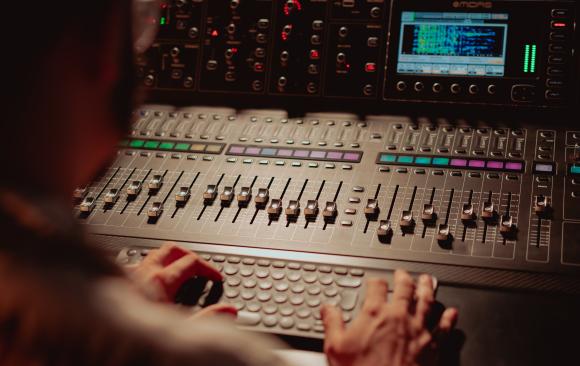Whether you're recording a podcast at home, interviewing someone for a documentary at their job, or doing any other kind of recording that includes audio, you need to consider your environment in order to get quality audio. Remember: sound clarity is key. Sound can be tricky to work with because the way we record sound doesn't quite align with the way we experience it. When you record video, you're only recording the images where your camera is pointed. You won't capture anything behind, above, below, or to the side of the camera's field of view. Sound, though, is all around us and interacts with the physical space we're in. So you might not only record sounds coming from the direction your microphone is pointed, but any and all sound bouncing around you.
Here are a couple of considerations you should make for setting up for recording sound:
- A quiet location will get you the best results. No matter the device you use to record, you need to find a space to record that is consistently quiet and free of unwanted noise. You may need to do some testing in different spaces until you find one that fits your needs. Our brain often ignores persistent sounds, especially in spaces we frequently spend time in. Fans, air conditioners, the compressor on a refrigerator, or just the regular traffic out the window all tend to fade from our attention over time. The microphone and audio recorder, though will still pick up many of those sounds! So, it's best to find a location to record where those sounds are minimal or nonexistent. If you must record in a space with windows that may sometimes result in traffic sounds coming through, heavy curtains or drapes can help with both quieting the sounds from outdoors and minimizing reverb.
- Minimize reverb in your recording space. A quiet space is just the first step. For best audio quality you want to avoid having too much reverb. Reverb is the natural echo of sounds that occurs in every kind of space, and it's a little different in every space. Reverb is the result of how sound interacts with physical objects.
If you've ever spoken or yelled in a large space with a hard floor and walls, like a cathedral or large church, you've experienced reverb. It's a bit like an echo. Reverb is most noticeable in large spaces because it takes more time for the sound to bounce off the walls and reach our ears (or the microphone). In smaller spaces reverb is less noticeable because it is heard or recorded almost at the same time as the original. Hard surfaces like walls or stone floors tend to result in stronger and more audible reverb because they don't abord the sound waves. A soft surface like a carpet, curtain, or even a blanket will absorb some and result in a weaker, less audible, reverb.
What does this mean for recording your podcast or video? Make sure the space you're recording in is carpeted and while you don't have to cover all your walls in blankets or curtains, finding ways to minimize reverb by hanging up soft materials can help a lot. Choosing a smaller space to record in is also very helpful.
- Know your equipment. Getting to know what your gear does and does not record well will go a long way to helping you get a better final product. Unfortunately, there is no single microphone or audio recording device that will guarantee you perfect results. Consider the following:
- Learn about your microphone. Different types of microphones have different purposes. For example, a microphone categorized as a condenser microphone tends to be better at picking up quieter sounds, while a dynamic microphone tends to be better for avoiding unwanted background noise. A lavalier microphone is great for video interviews because it's physically placed on your subject and tends to not pick up as much background noise. A shotgun microphone is ideal when you need to capture sound from a distance. There are a wide variety of factors in microphone construction. Learn about your microphone and what it does best.
- Learn about your audio recorder. Not all audio recorders are built the same but they all have one major consideration that is the same: the noise floor. The noise floor is the recording level at which you'll hear a constant hiss in the recording. On cheaper audio recorders this floor is higher, meaning you have very little room to increase the sensitivity of your recorder before you hear the hissing sound. On more expensive recorders the noise floor is lower, meaning you have more freedom to adjust your audio recorder's sensitivity to better capture quieter sounds. Test your audio recorder to find its limits.
Understanding some of the basic principles of how sound works, paying attention to where you're recording, and learning the nuances of your equipment can go a long way to elevating the quality of your project and making sure your work not only looks good, but sounds great, too.
To learn more about MNN and educational opportunities, visit us at: www.mnn.org/learn
Want more? Click here for our in-person classes!


